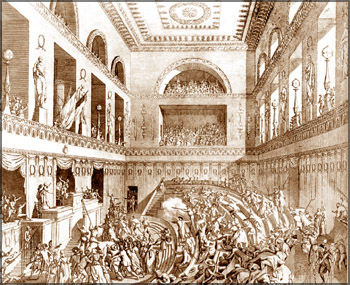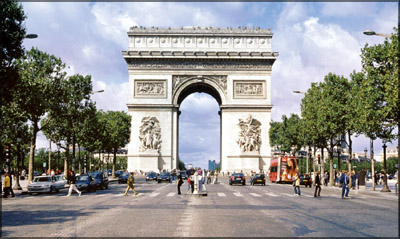Bastille Day: Birth of the French Republic
LIBERATION: Bastille Day, on the Fourteenth of July, is the
French symbol of the end of the Monarchy and the beginning of the First
Republic. The national holiday is a time when all citizens can feel
themselves to be members of a republican nation.
This national holiday is rooted in the history of the birth of the
Republic. On May 5, 1789, the King convened the Estates General to hear
their complaints: but the assembly of the Third Estate, representing the
citizens of the town, soon broke away and formed the Constituent
National Assembly.
On June 20, 1789, the deputies of the Third Estate took the oath of
the Jeu de Paume “to not separate until the Constitution had been
established.” The Deputies’ opposition was echoed by public opinion. The
people of Paris rose up and decided to march on the Bastille, a state
prison that stood for the absolute despotism of the Ancient Regime.
|

Storming the Bastille July 14, 1789
|
On July 14, 1789, the storming of the Bastille immediately took on a
great historical dimension; it was proof that power no longer resided in
the King as God’s representative, but in the people, in accordance with
the theories developed by their philosophers of the eighteenth century.
Within two days the Revolution could not be reversed. For all
citizens of France, the storming of the Bastille came to symbolize
liberty, democracy in the struggle against oppression.
France asserted its identity as a nation with the Revolution of 1789.
On 14 July 1790, a year after the fall of the Bastille, delegates from
all parts of the country flocked to Paris to celebrate the Fete de la
Federation and proclaim their allegiance to one national community.
This was the first example of a people in a European country
expressing their right (in modern times) to self-determination apart
from an hereditary ruler, a right the French claimed for themselves and
then offered as a model to all the nations of Europe and the world.
This display of national unity was deliberately organised on the
first anniversary of the fall of the Bastille, the first revolutionary
act by the people against the arbitrary power of the royalty, an act
that stamps France as one of the cradles of liberty.
Another outgrowth of this concept of a nation open to all who define
themselves as free men was the Declaration of the Rights of Man and the
Citizen (August 26 1789), which claimed to be universal in application.
Once freedom from the monarchy was won, the new rule had to be
codified. Jurists, inspired both by the philosophy of the Enlightenment
and by a long-standing French legalist tradition, dominated the
Estates-General.
This body, which became the National Constituent Assembly after the
Tennis Court Oath of 20 June 1789, gave France its first Constitution in
1791. Fifteen other Constitutions were to follow, leading to the 1958
Constitution that governs today.
Beneath this apparent constitutional instability may lie a genuine
concern for the “State” and for the ideal of
|

Arc de Tromphe, Paris
|
“public service,” defended by an administrators recruited on an
egalitarian basis (of merit).
From the start the French Constitutions were founded on a principle
new to most nations, the that of national sovereignty as opposed to
royal pleasure.
The King’s vacillation, his flight to Varennes and the appeal to
foreign forces to intervene eventually led to the downfall of the
constitutional monarchy.
After the attack on the Tuileries Palace on August 10, 1792, the
Republic was proclaimed on September 221792.
However, even upon Louis XVI’s execution on January 21, 1793, France
did not break completely with its monarchic heritage. It rejected the
idea of federalism and never applied the egalitarian principles of the
1793 Constitution.
Instead, in keeping with the Jacobin spirit, a highly centralised
policy was enforced under the authority of the Committee of Public
Safety, dominated by Robespierre.
Supporters claimed the policy was justified by the aggression of the
coalition of European monarchies outside France’s borders and by the
uprisings within. The coup d’‚tat of 18 Brumaire VIII (November 9, 1799)
put an end to the period of instability after Robespierre’s
assassination.
Bonaparte, one of the Republic’s most brilliant generals, became
First Consul, then Consul for Life before finally, in 1804, being
crowned Napoleon I, “Emperor of the French.”
After Napoleon’s final defeat at Waterloo in 1815 France once again
became a monarchy when Louis XVIII was called to the throne; he was
succeeded by Charles X and then, after the Revolution of July 1830,
Louis-Philippe.
The Restoration was followed by the Second Republic (1848-1851) and
the Second Empire (1852-1870).
In 1875 a republic was proclaimed for the third time; France has been
a republic ever since. The Third Republic enshrined in French political
tradition the seven-year presidential term, still the rule today.
At the end of the 19th century the French considered the enduring
gains of the Revolution to be the idea of the nation, one and
indivisible, based on a voluntary union and incorporating the principles
of human rights and national sovereignty, the rule of law and a
republican form of Government.
As they are associated with France, these concepts are symbolised by
the “Marseillaise,” the anthem to national unity composed in 1792 by
Rouget de Lisle.
Except for the period between 1815 and 1830, the Tricolour Flag has
represented France since the Revolution; it marries blue and red, the
colours of the city of Paris, with the royal colour of white. |

